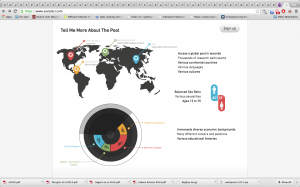Although in practice AutoMan and SurveyMan were both designed to make their backends pluggable, we have yet to implement an alternate backend for either because there simply aren’t any AMT competitors out there. There are plenty of crowdsourcing websites, but none are as programmable as AMT and few are as general. That is to say, all competitors appear to offer specialized labor markets and/or be designed for specialized work.
A known problem with the labor market on Amazon is that, even if you pay your workers minimum wage based on time actually spent on a task, they spend a significant amount of time searching for tasks. There are websites set up to facilitate this process, but it’s still time spent searching for work, instead of actually working. A major subfield of alternate approaches involves extracting work either voluntarily, or in contexts where non-monetary compensations make sense. Quizz uses Google’s advertising system to embed knowledge-mining quizzes in with its usual ads. Other approaches substitute consumer marketing tasks or questions for paywalls. In both cases, users are motivated by something other than payment.
I’ve been wondering for a while whether thefacebook would be a good platform for our software. Although the general understanding is that respondents are anonymized, but we know this is not true. Researchers have assumed that workers are independent. Recent work out of MSR has found that some Indian workers actually collaborate on tasks. For these reasons, I think Facebook would be a perfectly reasonable alternate platform for crowd sourcing. In fact, I believe that Facebook is a better platform for crowdsourcing, since it overcomes ones of the major shortcomings of AMT — people are already hanging out there*. Rather than appeal to a populace that is explicitly looking for work, sometimes as a primary source of income, we would like to instead use a Facebook to tap into people’s excess capacity**.
Since Facebook doesn’t currently have a crowdsourcing interface, could we mock up a substitute using what’s already available? Amazon currently handles listing, pool management, payment, presentation, and offers a sandboxed version of AMT for testing. A minimal implementation would involve hosting our own *Man servers and just using Facebook advertising to recruit workers. However, this diverts the user away from the Facebook ecosystem, which defeats the purpose of using Facebook in the first place (for example, we could just as easily use Google AdWords instead).
To keep users in the ecosystem, we could write a SurveyMan app***. I looked into this briefly, and while it isn’t as integrated into the main Facebook experience as I’d want, it’s closer than routing users to an outside website. We could use Facebook advertising to do the initial recruitment and then use wall updates to bootstrap that process. If Facebook advertising provided a way to target ads to particular demographics, we would have a better time with bias in our sample.
* Admittedly, I am not a regular user of thefacebook. I've heard the "so and so spends their whole day on facebook" complaint, but I really don't know how common this is. Consequently, this post is predicated on the idea that thefacebook is a place where people spend a lot of time, not doing work. I have heard that this is less the case since mobile became ubiquitous.
** TBH, I think the cult of excess capacity is unethical, but for the sake of capitalism and this blog post, let's assume it isn't. I will save a discuss of ethics and excess capacity later.
** Word on the street is that no one actually uses these things anyway...
